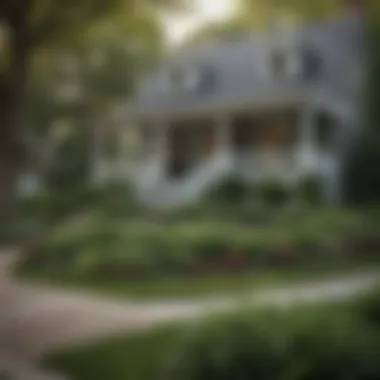Optimal Living: The Best Neighborhoods Near Chicago


Intro
Identifying the right location for living is crucial for anyone considering a move or investment in real estate. Choosing where to reside is not just about finding a house, but also about finding a community that fits one’s lifestyle and needs. The balance between urban excitement and suburban tranquility plays a significant role in these decisions. Around Chicago, numerous neighborhoods cater to a variety of preferences, making the city a rich tapestry of living options.
This article seeks to evaluate some of the best places to live around Chicago. Focusing on essential aspects such as community atmosphere, available amenities, educational facilities, and overall accessibility, we aim to provide prospective residents with the essential insights they need. From vibrant communities to quieter residential areas, this examination will assist in understanding what each neighborhood has to offer.
Architectural Inspiration
Overview of Design Styles
When considering the neighborhoods around Chicago, the architectural diversity is striking. Each area reflects a unique combination of historical influences and modern redesign. This interaction of styles enriches the locales, creating visually appealing streets and residences. Many neighborhoods showcase traditional brick homes hugging the shores of Lake Michigan, while others are scattered with contemporary glass and steel structures.
Popular styles include Chicago Bungalow, which features single-family homes known for their practicality and charm. Moreover, the Queen Anne architecture brings an artistic flair with its intricate details and distinctive gables. Exploring these elements can provide potential residents with a sense of the neighborhood's character.
Innovative Materials and Techniques
In recent years, there has been a shift towards sustainable building practices. Emerging neighborhoods are increasingly incorporating eco-friendly materials and techniques. Homes made from recycled materials, or those fitted with solar panels, signify a commitment not only to aesthetic values but also to environmental responsibility. This trend reflects a growing desire for living spaces that harmonize with nature and prioritizes energy efficiency.
"Investors and homebuyers today prioritize sustainability alongside architectural beauty."
Understanding these innovations can be particularly important for real estate enthusiasts who aim to invest in properties that align with modern values.
Interior Design Trends
Color Schemes and Their Psychological Effects
Color significantly influences a person’s mood and perception of space. Many trend-followers opt for neutral palettes combined with bold accents, establishing a balance that is both calming and stimulating. Soft shades of grey, beige, or taupe act as tranquil backdrops, while vibrant colors like teal or burgundy can infuse energy into a room. In homes around Chicago, such carefully selected color schemes resonate with the local environment's dynamic nature.
Space Optimization Tips
In the urban setting of Chicago, where space can be limited, home design often leans toward maximizing functionality. Techniques such as multi-functional furniture, built-in storage solutions, and open floor plans are popular. These strategies create an illusion of spaciousness while providing practical living solutions. Achieving both style and functionality in interior design reflects a common goal for many residents.
Navigating the various neighborhoods around Chicago requires careful consideration of multiple factors, including architectural styles and interior trends. This guide offers insights into what residents can expect as they explore their options for an optimal living experience.
Prolusion to Living Around Chicago
Living near Chicago offers a unique blend of urban excitement and suburban tranquility. Understanding the nuances of this area is essential for potential residents. The city and its surrounding suburbs present diverse neighborhoods, each with distinct characteristics and advantages.
Choosing a place to live involves several factors. These range from the cost of housing to the quality of schools and community culture. Chicago is well-known for its vibrant economy and cultural richness, making it a desirable location for many. However, what makes the suburbs equally compelling is their ability to offer alternative lifestyles for families, professionals, and retirees alike.
There are several critical elements to consider when evaluating living options around Chicago:
- Community Atmosphere: Each neighborhood has its own identity. Some areas are bustling with activities, while others provide a peaceful environment ideal for families.
- Amenities: Access to shopping, parks, and recreational facilities can greatly influence living decisions. Neighborhoods vary in this regard, making it necessary to research what is available.
- Educational Opportunities: Families often prioritize neighborhoods with strong schools. The educational landscape can differ significantly between urban and suburban settings.
- Accessibility: Transportation options, including proximity to trains and buses, can impact daily life.
"When you choose where to live, you are not just picking an address; you are choosing a lifestyle."
These considerations form the foundation of this article. By diving deeper into various neighborhoods, we aim to provide a comprehensive view of optimal living around Chicago. This will not only inform but also guide individuals in making practical choices based on their unique lifestyle needs.


Factors Influencing Housing Decisions
When considering a place to live, various factors significantly impact housing decisions. These elements encompass personal preferences and practical considerations. Understanding these influences is crucial for anyone looking to relocate, invest, or find a suitable living space around Chicago. Housing decisions can affect long-term satisfaction, financial stability, and overall quality of life.
Cost of Living Considerations
The cost of living is an essential factor to analyze. It includes housing prices, taxes, and utility costs. Potential residents must evaluate their budget relative to local market rates. Neighborhoods vary widely in this regard. For example, living in the West Loop can be quite expensive compared to areas like Logan Square. A useful strategy is to compare average home prices and rental rates alongside average salaries in the area.
This comparison can help individuals determine if a locality aligns with their financial resources. Additionally, residents should account for hidden costs, such as homeowners association fees and insurance, which can also impact overall affordability.
Quality of Education
Education systems can shape communities and influence housing decisions. For families, the quality of local schools is often at the forefront of their priorities. Areas with reputable schools, like Oak Park, attract parents eager to ensure their children receive a strong education. School district ratings, teacher-to-student ratios, and extracurricular options should all be considered.
Furthermore, proximity to higher education institutions may also appeal to young professionals and students. Communities that share a close relationship with colleges, such as Evanston, benefit from a vibrant academic atmosphere and cultural opportunities.
Commute and Transportation
Accessibility and commute times are vital factors in housing decisions. Living near public transport options can make daily travel more convenient. For instance, neighborhoods like Hyde Park and the South Loop offer excellent access to trains and buses, making commutes manageable. Another consideration is the balance between distance and travel time. Areas that seem affordable but require long commutes might not be as appealing in the long run. Evaluating traffic patterns and the availability of bicycle paths can add further insight to this decision-making process.
Local Amenities
Local amenities enhance living experiences and are crucial in choosing a neighborhood. Residents often look for shopping centers, grocery stores, health facilities, and recreational spaces nearby. For example, neighborhoods like Lincoln Park provide a rich array of parks and playgrounds, contributing positively to the lifestyle.
Also, the dining and entertainment options can reflect the community's pulse. Areas with vibrant restaurant scenes and cultural institutions, like Wicker Park, can draw individuals who value an active social life. A strong suite of local amenities provides convenience and enriches the daily experiences of residents.
Community and Safety
Security and local community dynamics are also key considerations. Potential homebuyers often research crime rates and community engagement levels within a neighborhood. Areas perceived as safe, such as Schaumburg, tend to draw families and individuals seeking peace of mind.
Moreover, a strong community connection can create welcoming environments. Neighborhoods that foster interaction, like those in Skokie, often have more engaging social dynamics. Assessing both quantitative data, like crime statistics, and qualitative data, such as online forums discussing neighborhood life, can provide a comprehensive view of community safety and dynamics.
"The balance between personal needs and community features can dictate housing choices significantly."
Urban Living: Neighborhoods Within Chicago
Understanding the various neighborhoods in Chicago is essential for anyone considering a move to the area. Urban living within this city offers an array of experiences that shape the lifestyle of residents. Each neighborhood comes with its unique character, amenities, and community vibe. This diversity allows potential residents to select areas that align with their personal values and needs. From vibrant arts districts to tranquil residential zones, the urban landscape of Chicago is as varied as its inhabitants.
Moreover, different neighborhoods cater to specific demographics, influencing choices for families, young professionals, and retirees alike. Accessibility to amenities such as retail outlets, parks, workplaces, and cultural institutions greatly impacts everyday life. Additionally, the local atmosphere plays a crucial role in how one perceives a neighborhood.
Identifying the right neighborhood can enhance overall quality of life, making urban living not just a practical decision but a pleasure.
The Loop: The Heart of the City
The Loop serves as the central business district of Chicago and is often referred to as the city's heartbeat. In this area, proximity to work and efficient public transport can save time and reduce commuting stress. Local attractions, like Millennium Park and the Art Institute of Chicago, provide residents with cultural and recreational options right at their doorstep.
Due to its bustling nature, The Loop appeals to young professionals who thrive in an urban environment filled with opportunities. However, the cost of living is higher here, which is an important factor to consider for potential residents.


Lincoln Park: A Blend of Nature and Culture
Lincoln Park is known for its expansive green spaces, including Lincoln Park Zoo and numerous nature trails. This neighborhood strikes a balance between urban vibrancy and natural beauty. Families are drawn to the area for its reputable schools and community activities. The lively dining and shopping scene also adds to its appeal.
It’s not just the amenities that make Lincoln Park attractive; it’s the strong sense of community. Residents often engage in local events, which fosters a connected environment.
Wicker Park: A Hub of Creativity
Wicker Park is celebrated for its artistic atmosphere. This neighborhood is home to a multitude of galleries, theaters, and live music venues that draw creative minds. Street art and murals adorn buildings, showcasing local talent.
Shops and eateries range from indie boutiques to upscale dining, catering to various tastes. Wicker Park is popular among millennials who appreciate its eclectic vibe and vibrant nightlife. Community involvement is evident through local initiatives and gatherings, reinforcing the sense of belonging.
South Loop: Growing Community with Potential
The South Loop is an area that has seen significant development recently. New construction projects have attracted a diverse population, including young couples and professionals seeking affordable housing with easy access to downtown. The presence of historical sites and modern conveniences creates a unique blend of old and new.
New residents benefit from the area's investment in local amenities, such as restaurants and retail shops. Furthermore, the ongoing development means that the neighborhood is likely to continue evolving, presenting opportunities for those looking to invest in property.
Hyde Park: Historical Significance and Diversity
Hyde Park is notable for its historical significance and academic presence, as it houses the University of Chicago. The neighborhood is rich in cultural diversity, which is reflected in its festivals and local cuisine.
Not only does Hyde Park offer access to excellent educational resources, but it also provides a range of housing options. From historic homes to modern apartments, there is something for everyone. Residents enjoy the blend of vibrant community life and the intellectual atmosphere that comes from being near a major university.
Suburban Appeal: Nearby Towns
The suburbs around Chicago offer unique advantages that are often overlooked by individuals focused solely on urban living. By exploring suburban options, residents can experience a different pace of life that combines accessibility to the city with quieter environments. Suburban towns generally provide more spacious living arrangements, which appeal to families and those seeking a break from dense city life. Additionally, these towns often foster a strong sense of community, making them ideal for individuals who prioritize relationships and shared activities.
The housing market in suburban areas tends to be more affordable compared to Chicago’s neighborhoods, allowing for better value for families or individuals looking to invest long-term. Schools in these regions often receive high ratings as well, making them particularly attractive for families with children. Other elements like parks, recreational facilities, and local events contribute to an enhanced lifestyle.
In this section, we will dive into distinct suburbs around Chicago, highlighting their unique characteristics and benefits:
Evanston: A College Town Vibe
Evanston stands out as a vibrant college town, home to Northwestern University. This nearby suburb provides an energetic atmosphere rich with diverse cultural experiences. Houses here range from historic mansions to modern apartments, catering to various lifestyles. Its proximity to Lake Michigan ensures residents can enjoy picturesque waterfront activities. The blend of academic influence and cultural institutions like the Block Museum fosters a vibrant community that attracts students and professionals alike. Evanston also hosts various festivals, enhancing its appeal even further.
Naperville: Family-Friendly Suburb
Naperville is recognized as a top family-friendly suburb. Lush parks spread throughout the area, offering numerous outdoor activities for children and families. The downtown area features inviting shops, restaurants, and the iconic Riverwalk, which provides a scenic area for leisurely walks. Naperville boasts excellent public schools, making it a popular choice for parents wanting quality education. The community's commitment to safety and quality of life enhances its attractiveness to homebuyers seeking stability and growth.
Oak Park: Architectural Heritage
Oak Park is renowned for its stunning architectural heritage, featuring numerous homes designed by famous architect Frank Lloyd Wright. The area showcases a unique blend of historical and contemporary architecture. When it comes to community life, Oak Park offers a charming downtown filled with local shops and dining options. The commitment to preserving its rich history while encouraging artistic expression makes this suburb a notable choice for design enthusiasts and history buffs.
Schaumburg: Commercial Center with Living Options
Schaumburg functions as a commercial hub, hosting a significant number of corporate offices and retail spaces. The Woodfield Mall, one of the largest shopping centers in the United States, draws visitors from all over. Residents appreciate the combination of urban conveniences and suburban comfort. Housing options vary from apartments to single-family homes, providing choices for many buyers. The suburb is also well-connected to public transportation, making commuting to Chicago straightforward and accessible.


Skokie: Cultural Diversity and Community
Skokie thrives on its cultural diversity, reflected in its food, events, and community initiatives. The suburb hosts various festivals, showcasing different cuisines and traditions. Its proximity to educational institutions and parks supports a vibrant lifestyle. Schools in Skokie are above average, catering to families seeking quality education for their children. The strong sense of community is evident in neighborhood events and local organizations, creating a welcoming atmosphere for newcomers.
In summary, exploring these nearby towns provides potential residents with a comprehensive perspective on suburban living options around Chicago. Each suburb brings unique characteristics and advantages, enabling individuals to find a place that truly resonates with their lifestyle and values.
Lifestyle Opportunities: Active Living and Recreation
In any urban or suburban area, the opportunities for active living and recreation are crucial to the overall appeal of the locations. In the context of Chicago and its surroundings, these factors do not just enrich community life; they also play a significant role in influencing housing decisions for families, individuals, and even retirees. Engaging in recreational activities fosters social connections, enhances physical health, and promotes mental well-being. For anyone interested in relocating or investing in property, understanding the lifestyle opportunities available is paramount.
Parks and Outdoor Spaces
Access to parks and outdoor spaces is an essential feature for neighborhoods around Chicago. Green spaces offer residents a chance to unwind, exercise, and engage with nature.
For instance, Lincoln Park boasts one of the largest urban parks in the United States, providing ample trails, gardens, and access to the lakefront. Meanwhile, Humboldt Park features expansive areas for recreation, including a lagoons and sports facilities. The presence of such parks supports not only leisure activities but also promotes community events, such as farmers' markets and festivals.
- Health Benefits: Regular access to parks encourages physical activities like walking, jogging, and cycling, contributing to improved health outcomes.
- Social Interaction: Parks serve as gathering spots for community gatherings, picnics, and family outings, strengthening neighborhood bonds.
Cultural Institutions and Events
Cultural institutions are an integral part of active living in and around Chicago. The city is rich in museums, theaters, and galleries that cater to diverse tastes. Besides the Art Institute of Chicago or the Field Museum, neighborhoods often have their own local cultural venues.
Significant community events take place throughout the year, providing opportunities for residents to engage with local culture and each other. Participating in these events helps foster a sense of belonging and enriches community life.
- Education and Awareness: Cultural institutions often host workshops and exhibitions, which add to the educational landscape, appealing to families seeking educational opportunities for their children.
- Diversity of Experience: Events and activities highlight diverse cultures, allowing residents to experience a variety of community traditions.
Dining Options and Culinary Scene
The culinary scene is one of the focal points for active living, especially in neighborhoods like Wicker Park and Hyde Park. Dining options not only offer nourishment but also serve as social hubs where residents gather to relax and enjoy culinary delights.
Neighborhoods around Chicago often feature a multitude of dining establishments, from trendy cafes to fine dining restaurants. Food festivals and farmers' markets add vibrancy to community life, creating further options for engagement.
- Culinary Festivals: Events throughout the year showcase local chefs and cuisines, attracting residents to discover new flavors and social experiences.
- Health-Conscious Choices: Many eateries emphasize fresh, locally-sourced ingredients, appealing to health-conscious individuals looking to maintain a balanced lifestyle.
Engaging in recreational activities significantly enhances the quality of life for residents and potential newcomers in the Chicago metropolitan area.
Culmination: Making the Right Choice
In the pursuit of optimal living around Chicago, the final decision about where to reside holds significant weight. Selecting the right neighborhood is not merely about the aesthetics of an area or its proximity to personal preferences; it encompasses a range of factors that interlink to define one's quality of life. The importance of this choice is underscored by the nuanced considerations outlined throughout the article.
First and foremost, evaluating community and environment cannot be overstated. Residents must assess how a neighborhood aligns with their lifestyle, values, and aspirations. For instance, some individuals may prioritize vibrant cultural scenes, while others seek tranquility and green spaces. Understanding these preferences helps in selecting a location that ensures a harmonious living experience.
The cost of living is another crucial factor. Budgetary constraints play an undeniable role in determining which neighborhoods are viable. Areas like Evanston and Naperville may boast appealing qualities, yet they also come with higher costs. Therefore, it's vital to cross-reference one's financial limits with the desired standard of living.
Furthermore, educational opportunities impact family choices significantly. Access to quality schools is paramount for families with children or individuals considering future investments. Locations with strong educational infrastructures, such as Oak Park and Schaumburg, often command higher demand and can influence real estate value.
The choice of a neighborhood is not a mere transaction; it is a decision that can affect daily life and long-term happiness.
In addition to these elements, commute and transportation options are essential considerations. Accessibility to workplaces and amenities can greatly affect day-to-day life. Areas that offer public transportation or efficient commuting routes, like the South Loop, tend to be more appealing to busy professionals.
Local amenities also contribute to the overall quality of living. Candidates should investigate the availability of parks, restaurants, and cultural institutions. Neighborhoods with robust amenities often enhance the overall living experience. For example, living in Lincoln Park provides access to nature while maintaining a vibrant urban environment.
Ultimately, the decision-making process should be thorough and well-informed. Potential residents must weigh all these factors carefully to arrive at a conclusion that suits their individual needs. Understanding the characteristics of each neighborhood, along with one's preferences and lifestyle, will ensure that the right choice is made.
Reflecting on the insights provided in this article, it becomes clear that each neighborhood has distinct advantages and challenges. Being mindful of these elements will facilitate a more satisfactory decision, paving the way for a rewarding living experience in and around Chicago.







